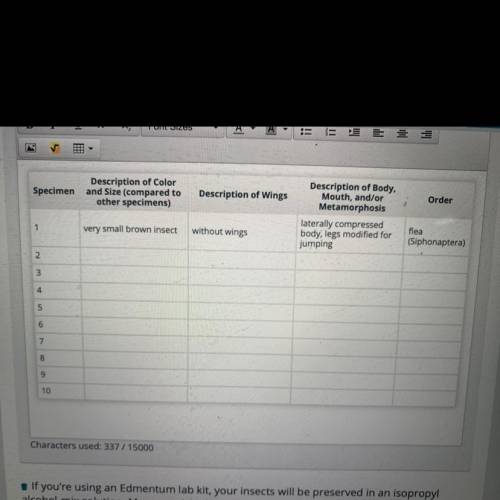25 points!!
Question 2
Now follow these directions to classify the insect specimens. Sta...

Biology, 24.03.2021 02:00 Lovebamagirl12
25 points!!
Question 2
Now follow these directions to classify the insect specimens. Start by putting on your
gloves and goggles. Then, using the forceps, remove all 15 insect specimens from
the jar and put them in the petri dishes.
Be very careful when removing the insects. Wings and body structures can be easily
damaged. Choose 10 insects that you want to classify using the dichotomous key,
and put the remaining insects back into the solution.
The dichotomous key that came with the Edmentum lab kit has descriptions and
"refer to" numbers. Start at Space 1, and determine whether your specimen has
wings. Jump to the "refer to" space to further classify the organism. Continue until
you reach the insect's order. If you're not using an Edmentum lab kit, follow the
instructions for your specific dichotomous key.
Now follow these steps to further classify each specimen. Write your notes in the
chart using the exact wording from the dichotomous key. An example is given in the
chart.
1. Use the magnifying glass to identify the body parts of each insect, such as the
mouth or wing structure. Use the microscope on the lowest or second-lowest
setting to observe the body parts of small insects.
2. Place the insect in the petri dish lid, and then place it on the microscope. (The
bottom part of the petri dish is too tall to fit under the microscope. Adjust the
upper microscope light instead of the base light. Then move the dish around
until you can see the specimen.)
3. In some cases, an insect's metamorphosis will determine its final order. Use
credible websites to look up the metamorphosis of insects belonging to
different orders, and match your specimens accordingly.
4. After you have studied all 10 insect, make sure your classification chart is
complete and that you have used the exact wording from the dichotomous key.


Answers: 3
Another question on Biology

Biology, 21.06.2019 13:30
Tall, cone-shaped mountains in which layers of lava alternate with layers of ash are called a. shield volcanoes. b. cinder cone volcanoes. c. composite volcanoes. d. lava plateaus. select the best answer from the choices provided a b c d i need asap
Answers: 1

Biology, 21.06.2019 20:00
After reading the paragraph below, answer the questions that follow. researchers have created a robot that has a very thin leg that is moved by cardiac (heart) cells contracting in unison. the robot, made of a polymer similar to that used in making contact lenses, is bathed in heart cells with supporting cells, which then attach to the robot and provide movement as they contract. all of the cardiac cells working together can cause the robot leg to move in a way that individual cells could not. this is an example of a. emergent properties of cells. b. energy flow through an ecosystem. c. adaptation. d. internal environment regulation.
Answers: 3

Biology, 22.06.2019 00:30
Compare and contrast cladistics and phylogeny. what are their advantages and disadvantages? which is the most useful in understanding how an organism developed into its current form? which concept most strongly supports your opinion about the origin of any given organism?
Answers: 1

Biology, 22.06.2019 01:00
Which statement describes john tuzo wilson’s contribution to the theory of plate tectonics?
Answers: 3
You know the right answer?
Questions




Chemistry, 07.10.2019 03:30









Mathematics, 07.10.2019 03:30

Social Studies, 07.10.2019 03:30

Biology, 07.10.2019 03:30




Mathematics, 07.10.2019 03:30



